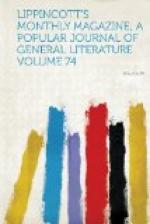The Lane has changed to-day. A Chinese grocer has, I hear, set up a shop in its midst. Some of its most noted characters have passed away, and the younger generation have taken on habits more American than those of their predecessors.
M.R.O.
A CHILD’S AUTOBIOGRAPHY.
A quaint and charming volume, which has fallen in our way, is Little Charlie’s Life, “the autobiography of a child between six and seven years of age, written with his own hand and without any assistance whatever.” It was at the urgent request of the gentleman who acted as editor, Rev. W.R. Clark—thus rescuing an inimitable little work from comparative oblivion—that the parents of the youthful author reluctantly consented to the publication of this curious delineation of child-life. From the date of his birth (1833), Charlie must have written his work some forty years ago. How long he was engaged in its composition is not stated, but from the internal evidence yielded by the spelling and the handwriting (for the work is lithographed in exact imitation of the manuscript) we should infer that it occupied two or three years, the handwriting of the first seven chapters being in imitation of ordinary printing, while the remaining chapters appear in an ordinary schoolboy’s hand. We may add that it is copiously illustrated by himself, and that the illustrations are worth their weight in gold, supplementing as they do, in a superfluously exact and curiously quaint manner, this most unique work.
He starts with this account of himself: “My name is Charles John Young, and I was born in Amfort, a pretty village in Hampshire, 1833 in July, that pleasant time when the birds sing merrily and flowers bloom sweetly. My father and mother are the kindest in the world, and I love them dearly and both alike. I shall give a description of them by and by. In the mean time I shall just say that my papa is a clergyman.”
The earlier chapters describe the various migrations of the family from one parish to another, and from them we have no difficulty in recognizing in “papa” the Rev. Julian Young, who possessed no small share of the talents that distinguished his father, the celebrated tragedian, Charles Young, and which seem to have been transmitted to our author, who, we understand, has honorably served his country in Her Majesty’s army. From his earliest years Charlie seems to have been strongly influenced by religious feelings. His creed was a bright and trustful one, a realization of God’s presence and of the need of speaking to Him as to one who could always hear and help. When he was about three years old, we are told in the editor’s interesting preface, he was often heard offering up little petitions for the supply of his child-like wants. Once, when, his nurse left him to fetch some more milk, his father overheard him saying, “O God, please let there be enough milk in the jug for me to have




